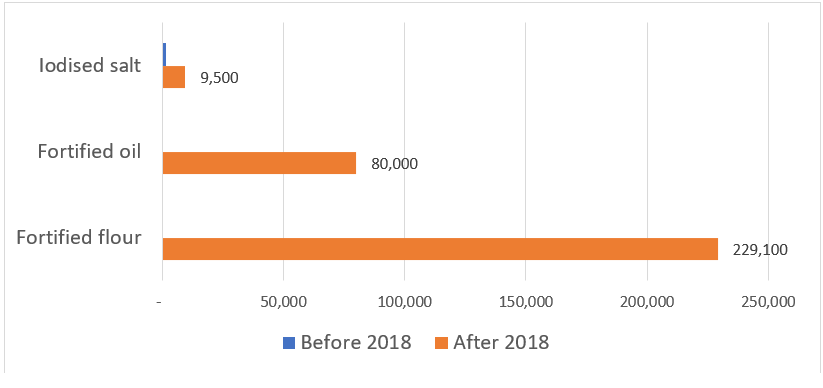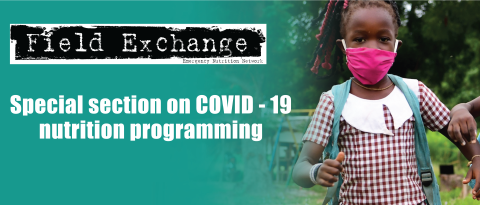Large-scale food fortification efforts in Haiti
This is a summary of a Field Exchange field article that was included in issue 65. The original article was authored by Ruth Climat, Yves-Laurent Régis and Chrisla Joseph.
Ruth Climat is the Technical Director of the Ranfòse Abitid Nitrisyon pou Fè Ogmante Sante (RANFOSE) project for Partners of the Americas.
Yves-Laurent Régis is the Chief of Party for the food fortification project implemented by Partners for Americas and the Global Alliance for Improved Nutrition (GAIN).
Chrisla Joseph is the project coordinator of the RANFOSE project.
The implementation of a national food fortification programme in Haiti has considerably improved the availability of micronutrients in wheat flour, oil and salt.
- A panel of experts identified that the fortification of wheat flour with iron and folic acid ranked second among 85 interventions that could have the most health, social, economic and environmental benefits in Haiti.
- The Ranfòse Abitid Nitrisyon pou Fè Ogmante Sante (RANFOSE) project supports food fortification by providing technical assistance, helping to create an enabling environment for the production and importation of fortified foods, establishing a quality assurance and control system and raising consumers' awareness of the benefits of fortified foods.
Current challenges include the lack of appropriate legal frameworks to support the adoption of fortified foods and inadequate quality control and assurance
Background
Micronutrient deficiencies have devastating consequences on populations, the clinical signs of which often only become visible after the deficiency has caused major internal damage. Micronutrient deficiencies are widespread in Haiti. In 2017, a panel of experts identified that the fortification of wheat flour with iron and folic acid ranked second among 85 interventions that could have the most health, social, economic and environmental benefits in Haiti. As a result, the Ministry of Public Health and Population (MSPP) adopted food fortification as a strategic objective of the national nutrition policy. In February 2017, the Parliament passed legislation requiring wheat flour to be fortified with vitamin B1, B2, B3, folic acid, iron and zinc, salt with iodine and edible oil with vitamin A.
RANFOSE project
To support the government's efforts, the United States Agency for International Development in Haiti launched the Ranfòse Abitid Nitrisyon pou Fè Ogmante Sante (RANFOSE) project in July 2017. Partners of the Americas and the Global Alliance for Improved Nutrition implemented the project in collaboration with the MSPP and other partners to:
- Create a legislative and regulatory environment that supports the production and importation of fortified foods in Haiti
- Make fortified foods that meet national standards available and accessible
- Establish a system of quality assurance, quality control and monitoring of sustainable fortified foods
- Educate consumers to understand and accept the benefits of fortified foods
The following activities have taken place in support of these efforts.
Creating an enabling environment
In March 2018, the project launched a Food Fortification Working Group that included members from the private sector, civil society, United Nations agencies, government entities and consumer associations. The group meets regularly to discuss progress and challenges associated with food fortification.
Provision of technical support
Technical support is provided to local businesses and importers to help identify needs and to ensure compliance. Working sessions are organised regularly with the relevant state authorities to strengthen their involvement in implementing food fortification.
Promotion of food fortification
In coordination with the MSPP, RANFOSE supported the development of awareness-raising materials and a radio and television communication campaign about the consequences of micronutrient deficiencies and the benefits of fortified foods. In addition, to help customers make an informed choice, a food fortification logo to be affixed to fortified products was developed and will be deployed upon final approval from the Department of Health.
Achievements of the programme to date
Today, all locally produced foods targeted for fortification are now available in a fortified version in the local market compared to 2018 when availability was virtually none (Figure 3).
Figure 3: Availability of foods fortified in Haiti before and after 2018, in metric tons

Wheat Flour
There are three companies fortifying local flour and some imports are also fortified although adjustments are still underway to adapt the levels of fortification to meet the recommendations of the MSPP. Currently, over three-quarters of the flour available on the Haitian market is appropriately fortified.
Vegetable oil
Approximately 80% of the oil available on the Haitian market is fortified. There are two oil mills (that represent roughly 50% of the Haitian market share) that have been fortifying oil with vitamin A while several major importers have also taken the step to import fortified oil.
Salt
The vast majority of iodised salt available in Haiti is imported and does not comply with MSPP recommendations; only approximately 16% of available salt is appropriately fortified. A new distributor has recently joined increasing the potential to further improve the availability of appropriately fortified salt. Meanwhile, sales of locally-produced iodised salt have increased, likely due to the promotional efforts of the MSPP.
Challenges to food fortification in Haiti
In spite of the successes of the national food fortification programme in Haiti, there have been major challenges to its progress, many of which are a result of the prolonged political crisis in the country:
- Violent street demonstrations, roadblocks and fuel shortages have hindered the transportation of fortified products
- Frequent changes in government have affected planning and coordination with public entities with some essential pillars of the legal framework for fortified foods still not yet in place
- The deteriorating economic situation has limited the population's access to fortified foods, exacerbated further by the COVID-19 pandemic
- Companies that voluntarily adopt fortification and absorb the associated costs do not receive support or incentives while those who do not fortify their products are not penalised
- Quality assurance and control systems are inefficient while national laboratories lack the capacity to provide appropriate quality control testing
Conclusion
Efforts by the government in recent years, supported by the RANFOSE project, have considerably improved the availability of micronutrients in oil, salt and wheat flour in Haiti. Targeted efforts are needed to overcome the challenges to ensure the full and sustainable rollout of food fortification. To this end, RANFOSE will continue to advocate for:
- The publication of technical legal texts by the Haitian government
- Improved quality control and collaboration between industries and laboratories to guarantee a sustainable food control system
- The development and dissemination of norms and standard operating procedures for fortification
RANFOSE and its partners will also continue to invest in communication campaigns to raise awareness of the importance of fortified foods to maintain demand and project sustainability towards achieving improved health and nutrition throughout the country.
For more information, please contact RANFOSE at ranfose@gmail.com.


